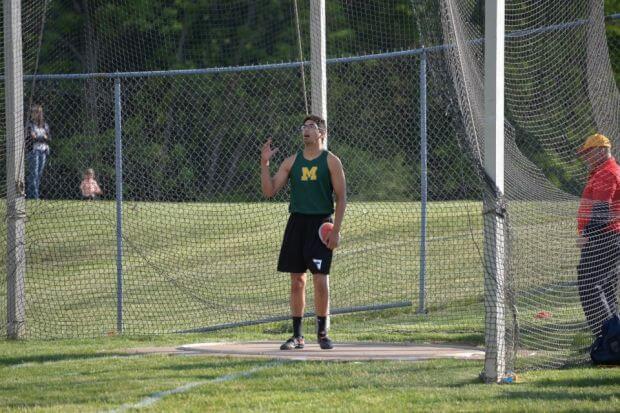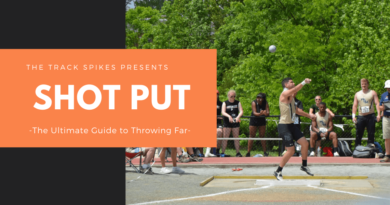Discus Throw: How to Improve by 10+ Feet This Season
If you’re looking to improve your discus throw personal best, you’ve come to the right place. You are only one cue or one change away from hitting that big throw. Let’s work together and help you move forward to have your best season yet.

The first thing you’re going to have to realize is that a change like this will not happen overnight. It took me four years of non-stop practice to even start competing with the top athletes in New Jersey my senior year. I’ve taken way over 10,000 discus throws alone in my life, and I’d do it all over again. Just realize, that this will take a lot of work. There will be rainy days that decide who wants it more: you or the competitor in your county, conference or state.
In order to be successful in discus, you will need the following things:
- An inner drive to become the best. I know. This is cheesy. But, becoming great at this sport will require you to throw 4-5x a week, 20-30 throws per day (depending on where your season is) for at least 50 weeks a year.
- You’ll need a coach. Chances are that you already have a coach. But, I’d largely recommend getting an outside coach for different perspective. That way, you can communicate your specific goals with the everyday coach watching you, and you can keep a bigger picture mindset with your goals.
Getting the Right Gear to Help You Maximize Every Single Discus Practice
There are several parts of discus practice that will require specific gear. Here, we can align for you what exactly you need to maximize efficiency in your practices

- Throwing Shoes – As a supplement to your training, you have to invest into some throwing shoes like the Nike Zoom Rival SD’s. These shoes were our #1 top rated throwing shoes in our post: “The 3 Best Throwing Shoes for Shot Put, Discus & Hammer”.
- Camera – I’d also suggest using an iPhone or buying a separate camera to record your throwing sessions. I use a separate camera simply because I don’t want my iPhone storage being bogged down by my videos from practice. If you’re going to purchase a camera, I would recommend this one.
- Discus – You should be bringing 1-2 discus’ with you to every practice to maximize efficiency. It’s usually best if you have a shed near your circle, but if you don’t, always make sure to bring your implements. Depending on your level of skill, it might also be a worthwhile investment to purchase heavier discs. This will help you slow down and feel all of your positions through the circle.
- Gill Athletics Discus 1.0 kg – For Women in High School & College, this is a great option for practice
- Nelco Super Spin 1.0kg – This is a great competition discus for women in high school and in college
- Polanik Carbon Competition Discus 1.6kg – This is a similar discus to what I used when i competed
- Martin Sports Discus 2.0kg – For men in college, this is a cheap alternative to have and practice with everyday.
How To Improve Your Personal Record in the Discus Throw event
For each throwing session, you should record at least three videos of full solid throws. That way, you’ll have three videos to evaluate after your practice. You will need to evaluate these videos after every single practice. Even if it’s for 15-30 minutes, you need to give yourself space to reflect and figure out what can be done the next day.
I see so many athletes mindlessly heading into practice without a goal for that day. As a shot put or discus thrower, your head always needs to be focused on 1-3 cues during practice. In a meet, you should really just focus on 1 cue to smash it during competition.
Here’s the golden nugget: By consistently evaluating yourself after every practice, you will begin to hone in your flaws and your strengths. I kept a physical journal, which then turned into a electronic journal where I kept record of:
- How many throws did I take that practice?
- What are the 1-3 cues that I worked on?
- Identify what did you do well this practice?
- What can I improve and focus on for the next practice?
Keeping a training journal completely changed the game for me. Once I became consistent in doing my 15 – 30 mins post-practice evaluation, I started to come in a lot more confident into my practices. There were days that I really didn’t want to do this, however, I did it anyway. If you want to get better, this golden nugget right here can change your performance forever.
I actually made a Google Forms app that would ask me the listed questions above. I then was able to import those daily responses into a Google Sheets, where I had fully access to to all of the days neatly laid out on a spreadsheet.
Okay, what next?
Once you’ve got your hands on new gear and a training journal, the next thing you’ll have to do is understanding your strengths and weaknesses as a thrower.
Conducting this self-analysis on yourself will help understand your natural tendencies with upsides and downsides of your technique. You will begin to notice patterns after you throw. For example, when I was in college, after a heavy lifting day, I would always be cut out the back because of fatigue. I also noticed that since I was taller, the angle of my release and reach over the toe board was extremely important to my throws.
If you want to evaluate yourself, one thing you’ll need to take note of everyday is how you feel. If you’re fatigued, it’s important to slow down and make sure that you are still making technical progress. The discus throw requires both strength and precision to make the it go far.
Cues That Will Help You Throw Far
Everyone wants to throw far, but no one wants to get into the nitty gritty and dial in on a few cues that will make you better.
These cues were collected after several years of receiving feedback from multiple coaches. I’ve also provided these cues to students and found significant improvement in their distance.
Cue #1 – Keep your discus up in your windup, because that’ll be reflective of your power throw.
I’ve seen very unique warmups from throwers, but one of the main ones I see is that throwers will keep their discus low in their windup. You should aim to keep your discus up near or above shoulder level. By starting off with the discus above your shoulder, you will help yourself keeping your discus up, especially in the middle of the thrower.
The most important time to keep to your discus is in the middle of the throw. If you can land in your power position with the discus up higher, you’re going to allow yourself for optimal angle of release for the discus. The optimal angle of release for the discus throw is anywhere between 32 – 37 degrees. Understanding this conceptually will help you because you’ll feel yourself “catching” the discus back high, and it will set you up so that you can release the discus perfectly every time.
One thrower that does a great job of keeping the discus up is Sandra Perkovic. Watch her in the beginning of the throw. Her discus is up HIGH. As a result, she catches the discus HIGH as she gets both feet down at the front of the circle.
One thing that I see beginner throwers is that they do several windups. They stand there swinging their discus around 3-4 times. This can actually be detrimental to the overall rhythm of your throw. You’ll see that all of the professional athletes competing in the discus throw only windup once. If the professionals aren’t doing it, why should you? Why reinvent the wheel? Let me be clear: this is not a call to copy an Olympian’s technique. Let me be clear: I don’t believe that discus throwers should go out and copy Robert Fazekas’ technique. However, the fundamentals of his throws are very sound, and that can be copied.
Cue #2 – Focus on being stable out of the back of the circle
As you get out of the windup, your first inclination will be to immediately get to the middle of the circle. The key to setting up your discus throw overall is by being patience out of the back. One thing that you can focus on is really drilling in the 180 and 360 drills.
The key concept behind this is that by being stable out the back, you will be able to drive first with the lower body. One of my friends (both him and I were right-handed throwers) always used to talk about “getting left”. This was the concept that you could leverage space outside of the circle to throw far. For example, if you’re able to extend your left arm out the back, you’ll turn around the left foot with an extended right leg. The path becomes longer and allows you to turn rotational energy into linear energy.
One thrower that does this extremely well is Ryan Crouser. Although he is mainly known for being a shot putter, he actually holds the US High School Record for discus.
The reason why Ryan Crouser looks slow in this throw is because he’s focusing on getting left out of the back. He’s able to perfectly setup the throw, and then explode through the middle.
Cue #3 – Get your left foot down quickly and blast through your throw but keeping contact with your right foot
I used to watch this video regularly just to understand how he finishes his throw. The technique he is using is called a non-reverse. How you finish your throw is based on preference. I usually use non-reverses to work on keeping my right foot down and turning all the way through the door.
When you’re in the middle of your throw, think about getting the left foot down quicker so that you can feel some serious chest-hip separation. As long as you can get that left foot down, you’ll be able to turn through.
This is called using your block leg. It will transfer all of your energy from your throw into your right side. By activating your right side, you will have tremendous power as you begin to release the discus.
Cue #4 – As you go through the circle, keep your arms as long as can be.
Just think about it – if you’re all scrunched up in the middle of your throw, you’re not going to throw as far. I see this happening with so many throwers, myself included. This would mainly happen to me when I would start training with heavier weight. Naturally, the discus will begin to drop especially if you’re not strong enough to physically control it. Or you could have perfect control of the discus, and just be super excited to throw that you keep it close to your body.
Conclusion
Bottom line: Gaining several feet to your discus throw personal record will take a lot of time. You have to be willing to put in the work to strive and become best in your country, best in your conference and eventually best in your state. Throwing discus has been one of the best experiences of my life. You learn an awful lot about yourself when you succeed and fail. You learn how badly you want to win. Lastly, you learn that you have no limit beyond what you decide to put in. Those who are disciplined will succeed over those who are naturally gifted. However, those who are naturally gifted and hard working will become unstoppable.


